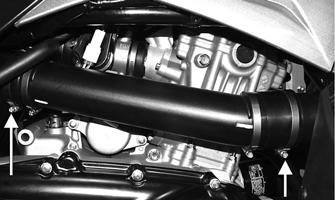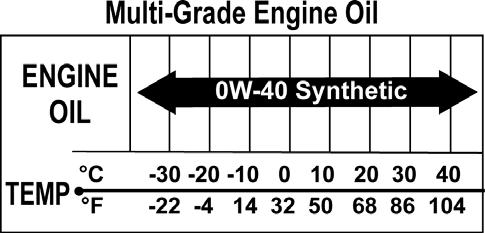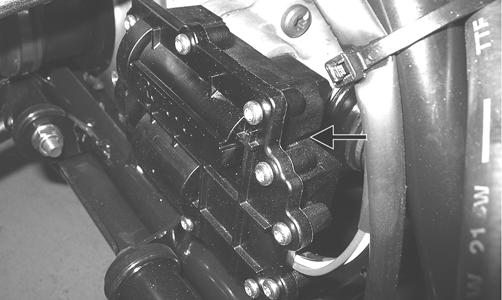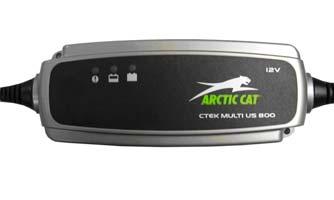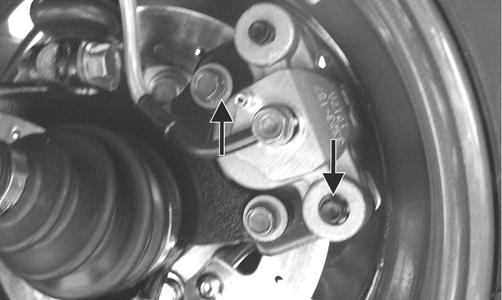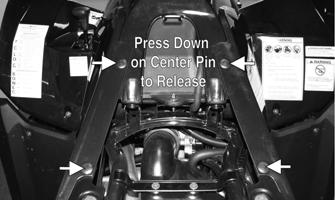
10 minute read
Fuel/Lubrication/Cooling
! WARNING
Whenever any maintenance or inspection is performed on the fuel system during which there may be fuel leakage, there should be no welding, smoking, open flames, etc., in the area.
TROUBLESHOOTING 1.Verify that the electric fuel pump is operating by listening for a “whirring” sound for several seconds after the ignition switch is turned to the ON position.
If no sound can be heard, see Electrical System - EFI
Sensors/Components. 2.Check for a flashing EFI icon on the LCD. If EFI is flashing, see EFI Diagnostic System in the Electrical
System section. 3.Make sure there is sufficient, clean gas in the gas tank. SPECIAL TOOLS A number of special tools must be available to the technician when performing service procedures in this section. Refer to the current Special Tools Catalog for the appropriate tool description. NOTE: When indicated for use, each special tool
will be identified by its specific name, as shown in the chart below, and capitalized.
Description p/n Oil Pressure Test Kit 0644-495
Tachometer 0644-275 Fuel Pressure Test Kit 0644-571
NOTE: Special tools are available from the Arctic
Cat Service Department.
Throttle Body
REMOVING 1.Remove the heat shields and seat. 2.Disconnect the negative battery cable; then remove the gas tank (see Gas Tank in this section).
3.Loosen the clamp securing the intake boot to the throttle body; then loosen the clamp securing the intake boot to the intake housing and slide the intake housing rearward.
! WARNING
Gasoline may be under pressure. Place an absorbent towel under the connector to absorb any gasoline spray when disconnecting.
FI691A
4.Disconnect the TMAP sensor connector, ISC connector, and TPS connector; then loosen the clamp securing the throttle body to the intake manifold boot and slide the throttle body out.
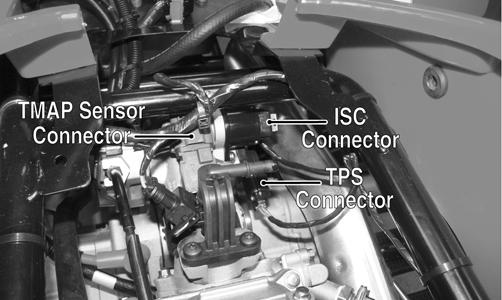
FI528C
5.Remove the throttle arm cover and loosen the throttle cable jam nut; then disconnect the throttle cable and remove the throttle body. INSTALLING 1.Connect the throttle cable to the throttle arm; then install the throttle cable housing in the throttle body and tighten the jam nut. Install the throttle arm cover and secure with two machine screws. 2.Place the throttle body into the intake manifold boot and tighten the boot clamp securely. 3.Connect the TPS connector, ISC connector, and the
TMAP sensor connector. 4.Place the intake housing into the boots and tighten the boot clamps securely. 5.Install the gas tank; then the heat shields and seat. 6.Check throttle cable free-play (see Periodic Maintenance/Tune-Up). NOTE: If the throttle body, ECM, TPS, or ISC are
replaced, the EFI system must be synchronized. Use the following procedure.
1.With the key off, depress the throttle lever to Wide
Open Throttle (WOT). 2.Place the ignition key in the ON position and wait for 10 seconds. 3.Release the throttle lever and wait an additional 10 seconds.
Throttle Cable Free-Play
To adjust the throttle cable free-play, follow this procedure. 1.Slide the rubber boot away; then loosen the jam nut from the throttle cable adjuster.

AL611D
2.Turn the adjuster until the throttle cable has proper free-play of 3-6 mm (1/8-1/4 in.) at the lever.

CF297A
3.Tighten the jam nut against the throttle cable adjuster securely; then slide the rubber boot over the adjuster.
Gas Tank
! WARNING
Whenever any maintenance or inspection is made on the fuel system during which there may be fuel leakage, there should be no welding, smoking, open flames, etc., in the area.
REMOVING 1.Remove the battery case access cover from the battery case; then disconnect the negative battery cable and remove the seat. 2.Remove the reinstallable rivets securing the side panels (two on each side) and remove the side panels.

KC450A
NOTE: The reinstallable rivets may be easily
released by depressing the pin in the center of the head.
3.Remove two cap screws and four reinstallable rivets from the gas tank cover; then remove the gas tank cap and remove the cover panel. Reinstall the gas tank cap.

KC453A

KC454A
4.Using a shop towel to catch any leaking gasoline, disconnect the gasline hose from the fuel pump outlet; then disconnect the fuel pump/fuel gauge connector from the harness.

KC455

KC456
5.Remove the mounting bolt at the rear of the gas tank; then remove the gas tank.

KC457A
6.Remove the heat shield by reaching under the front of the shield and compressing the retainer posts to release.

KC459A
CLEANING AND INSPECTING 1.Clean all gas tank components with parts-cleaning solvent. 2.Inspect all hoses for cracks or leaks. 3.Inspect tank cap and tank for leaks, holes, and damaged threads. INSTALLING 1.Install the heat shield making sure the mounting studs lock in the bracket; then install the gas tank and secure with the mounting bolt. Tighten securely.

KC458A
2.Connect the gasline hose connector to the fuel pump outlet making sure it locks securely in place; then connect the fuel pump/fuel gauge connector to the harness. 3.Remove the gas tank cap and place the gas tank cover over the gas tank. Install the gas tank cap; then secure the cover with four reinstallable rivets and two cap screws. 4.Install the side panels and secure with reinstallable rivets making sure the tabs on the panels engage the slots on the gas tank cover. 5.Connect the negative battery cable and install the battery case access cover; then install the seat.
Oil Pump
NOTE: Whenever internal engine components wear
excessively or break and whenever oil is contaminated, the oil pump should be replaced. The oil pump is not a serviceable component.
TESTING OIL PUMP PRESSURE 1.Connect the Tachometer to the engine. 2.Connect the Oil Pressure Test Kit to the oil filter drain plug.
KC195A

KC267

NOTE: Some oil seepage may occur when installing
the oil pressure gauge. Wipe up oil residue with a cloth.
3.Warm up the engine to normal operating temperature (cooling fan cycling); then increase engine RPM to 3000 RPM. The oil pressure must read 0.6-0.7 kg/ cm2 (8.5-10 psi).
KC268

NOTE: If the oil pressure is lower than specified,
check for low oil level or defective oil pump.
NOTE: If the oil pressure is higher than specified,
check for clogged oil passage, clogged oil filter, or improper installation of the oil filter.
Liquid Cooling System
When filling the cooling system, use a coolant/water mixture which will satisfy the coldest anticipated weather conditions of the area in accordance with the coolant manufacturer’s recommendations.
Checking/Filling 1.Locate the coolant reservoir on the right side behind the radiator. 2.Remove the cap and fill with the appropriate coolant until coolant level is between the LOW and FULL lines. Do not overfill.

KC396A
3.Install the cap on the reservoir.
While the cooling system is being filled, air pockets may develop; therefore, run the engine for five minutes after the initial fill, shut the engine off, and then fill the cooling system to the bottom of the stand pipe in the radiator neck. RADIATOR Removing 1.Drain the coolant at the engine. 2.Remove the radiator/electrical access panel and front fender panel (see Front Body Panel/Fender). 3.Remove the upper and lower coolant hoses; then remove the fill hose and air bleed hose. 4.Remove the cap screws securing the radiator to the frame. 5.Disconnect the fan wiring from the main wiring harness; then remove the radiator/fan assembly and account for the grommets and collars. 6.Remove the fan/fan shroud assembly from the radiator. Cleaning and Inspecting 1.Flush the radiator with water to remove any contaminants. 2.Inspect the radiator for leaks and damage. 3.Inspect all hoses for cracks and deterioration. 4.Inspect all fasteners and grommets for damage or wear. Installing 1.Position the fan/fan shroud assembly on the radiator; then secure with existing hardware.
CAUTION
After operating the ATV for the initial 5-10 minutes, stop the engine, allow the engine to cool down, and check the coolant level. Add coolant as necessary.
2.Place the radiator with grommets and collars into position on the frame; then install the cap screws.
Tighten securely. 3.Install the upper and lower coolant hoses, fill hose, and air bleed hose; then secure with hose clamps.

AF734D
4.Install the radiator/electrical access panel; then install the front fender panel (see Front Body Panel/
Fender). 5.Fill the cooling system with the recommended amount of antifreeze. Check for leakage. 6.Connect the fan wiring to the main wiring harness. THERMOSTAT Removing 1.Drain approximately one quart of coolant from the cooling system.
2.Remove the two cap screws securing the thermostat housing to the mounting bracket. Remove the thermostat housing cover and account for an O-ring and a thermostat. Inspecting 1.Inspect the thermostat for corrosion or spring damage. 2.Using the following procedure, inspect the thermostat for proper operation. A.Suspend the thermostat in a container filled with water. B.Heat the water and monitor the temperature with a thermometer. C.The thermostat should start to open at 80-84° C (176183° F). D.If the thermostat does not open, it must be replaced. 3.Inspect all coolant hoses, connections, and clamps for deterioration, cracks, and wear. NOTE: All coolant hoses and clamps should be
replaced every four years or 4000 miles.
Installing 1.Place the thermostat and O-ring into the thermostat housing; then secure the thermostat housing to the mounting bracket with the two cap screws.
2.Fill the cooling system to the recommended level with antifreeze. Check for leakage. WATER PUMP NOTE: The water pump is a non-serviceable com-
ponent. It must be replaced as an assembly.
Removing 1.Remove the radiator cap; then remove the water pump drain and drain the coolant.

FI530A
2.Drain the oil from the engine/transmission. 3.Remove the four torx-head cap screws securing the front and rear fenders to the footrest; then remove the four cap screws securing the footrest to the frame.
Remove the footrest. 4.Loosen the hose clamps and slide the clamps away from the hose ends approximately 2 in.; then remove the hoses from the water pump. 5.Remove the four cap screws securing the water pump to the engine; then remove the water pump.

FI538A
Installing 1.Secure the water pump to the engine with the four cap screws tightened to 8 ft-lb.

FI538A
2.Connect the coolant hoses to the water pump and secure with the clamps. Tighten securely.

FI530
3.Place the footrest into position on the frame and loosely secure with four cap screws; then secure the front and rear fenders to the footrest with the four torx-head cap screws. Tighten the four torx-head cap screws securely; then tighten the remaining cap screws to 20 ft-lb. 4.Fill the engine/transmission with the proper amount of recommended oil. 5.Fill the cooling system with the proper amount of recommended coolant.
Troubleshooting
Problem: Starting impaired Condition Remedy
1. Gas contaminated
1.Drain gas tank and fill with clean gas
Problem: Idling or low speed impaired Condition Remedy
1. TPS out of adjustment 1.Adjust TPS
Problem: Medium or high speed impaired Condition Remedy
1. High RPM “cut out” against RPM limiter 1.Decrease RPM speed

